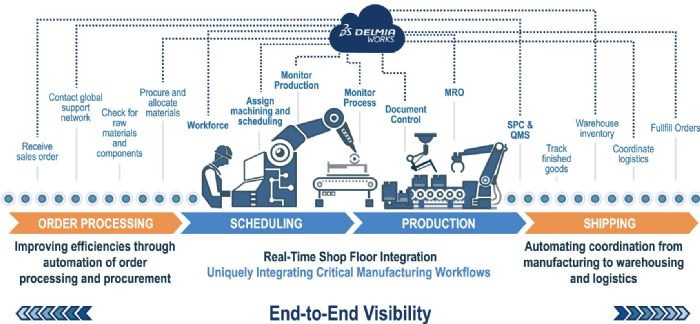2025 Trends in Metal Fabrication
February 21, 2025Comments
Front and center: connected workers, enabling fewer people to perform multiple tasks by providing semi-autonomous automation aids in workcenter job instructions, inline quality inspections, and systems for workflow tracking and exception reporting.
Metal formers and fabricators are adopting several business and technology strategies to continue growing their operations profitably in a rapidly evolving industry landscape. Several companies shared their strategies in a series of discussions with DelmiaWorks’ chief marketing officer Steve Bieszczat. MetalForming spoke with Bieszczat about the trends he sees based on those discussions.
MetalForming: What dominant business trends do metal formers and fabricators face in 2025?
Bieszczat: Three trends stand out. Top of mind for many companies is moving from offshoring to onshoring. Geopolitical rivalries and an emerging wave of tariffs have caused considerable concern among metal fabricators about being overly reliant on offshore production and supply chains. Nearshoring was thought to be “Plan A” in replacing production in China. However, with the recent tariffs on steel and additional tariffs on several trading partners, including Mexico and Canada, still potentially on the table, there’s growing interest in further advancing onshore production. We see this as an increased investment in onshore tool-building capabilities, and also suspect that some acquisitions will be driven by a desire to hedge domestic capacity.
That leads us to the second trend: There should be no long-term slowdown in merger and acquisition (M&A) activity. We continue to see a consolidation of ownership across the metal-fabrication industry in deals that largely take one of two forms:
- Strategic buyers acquire capabilities and capacity to build out their own go-to-market strategies.
- Financial investors are investing in platform companies for manufacturing niches and then building on those platforms through the acquisition of companies with similar product lines.
Interest rates and political questions may have slowed M&A activity in 2024 and perhaps into early 2025, but long term, strategic and financial buys will continue to consolidate industry ownership.
Third, lightweighting will be a core requirement for automotive suppliers. The eco-push on vehicles is built into the marketplace. Lightweighting—offering the same performance, strength and safety in a lighter-weight option—saves fuel in gas-powered vehicles and extends the range of electrical vehicles. It is something every automaker wants and is willing to pay for. As one manufacturer noted, “If you’re working with Detroit, every ounce counts.”
So, in 2025, particularly in the wake of steel tariffs, we expect to see automotive companies place an even higher priority on metal fabricators, suppliers and contract manufacturers to deliver parts and assemblies that contribute to the lightweighting of their vehicles.






 MetalForming:
MetalForming:
